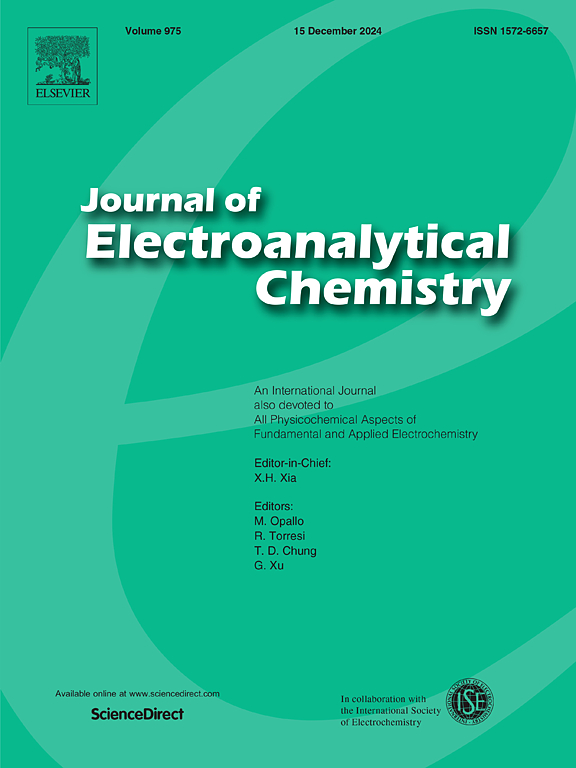高效稳定的MoCo-Ni(OH) 2 /NF电催化剂在废PET乙二醇氧化升级利用中的应用
IF 4.1
3区 化学
Q1 CHEMISTRY, ANALYTICAL
引用次数: 0
摘要
聚对苯二甲酸乙二醇酯(PET)塑料的生产和消费不断增加,由于广泛的垃圾填埋处理和资源枯竭,对环境构成了重大挑战。PET的电化学升级回收,特别是通过电催化氧化乙二醇(EG)生成甲酸,提供了一个有前途的可持续解决方案。然而,EGOR反应的复杂性要求开发高效和选择性的电催化剂。本文报道了一种新型MoCo共掺杂Ni(OH)₂纳米片催化剂的设计和合成,该催化剂负载在泡沫镍(NF)上,标记为MoCo - Ni(OH)₂/NF,用于增强EGOR。在受控的生长过程中,MoCo-Ni (OH)₂纳米片均匀分布在NF衬底上,形成独特的花状形貌。所制备的MoCo-Ni (OH) 2 /NF催化剂具有优异的EGOR性能,在1.37 V(相对于RHE)条件下生成甲酸的法拉第效率高达72.28%,甲酸产率达到600 μmol h−1 cm−2。此外,该催化剂表现出优异的稳定性,在长期测试后仍能保持其形态和表面化学性质。这项工作强调了MoCo-Ni (OH) 2 /NF作为一种高性能电催化剂的潜力,可用于废弃PET的可持续升级回收。本文章由计算机程序翻译,如有差异,请以英文原文为准。

Efficient and Stable MoCo-Ni(OH)₂/NF electrocatalyst for the Upcycling of Waste PET via Ethylene Glycol Oxidation
The escalating production and consumption of polyethylene terephthalate (PET) plastics pose a significant environmental challenge due to widespread landfill disposal and resource depletion. Electrochemical upcycling of PET, particularly through the electrocatalytic oxidation of ethylene glycol (EG) to formate, offers a promising sustainable solution. However, the complex nature of the EGOR reaction necessitates the development of highly efficient and selective electrocatalysts. This work reports the design and synthesis of a novel MoCo co-doped Ni(OH)₂ nanosheet catalyst supported on nickel foam (NF), denoted as MoCo–Ni(OH)₂/NF, for enhanced EGOR. The controlled growth process yields a distinctive flower-like morphology of MoCo–Ni(OH)₂ nanosheets uniformly distributed on the NF substrate. The resulting MoCo–Ni(OH)₂/NF catalyst exhibits remarkable EGOR performance, achieving a high Faradaic efficiency of 72.28 % for formate production at 1.37 V (vs. RHE) and an impressive formate yield rate of 600 μmol h−1 cm−2. Furthermore, the catalyst demonstrates exceptional stability, retaining its morphology and surface chemistry after extended testing. This work highlights the potential of MoCo–Ni(OH)₂/NF as a high-performance electrocatalyst for the sustainable upcycling of waste PET.
求助全文
通过发布文献求助,成功后即可免费获取论文全文。
去求助
来源期刊
CiteScore
7.80
自引率
6.70%
发文量
912
审稿时长
2.4 months
期刊介绍:
The Journal of Electroanalytical Chemistry is the foremost international journal devoted to the interdisciplinary subject of electrochemistry in all its aspects, theoretical as well as applied.
Electrochemistry is a wide ranging area that is in a state of continuous evolution. Rather than compiling a long list of topics covered by the Journal, the editors would like to draw particular attention to the key issues of novelty, topicality and quality. Papers should present new and interesting electrochemical science in a way that is accessible to the reader. The presentation and discussion should be at a level that is consistent with the international status of the Journal. Reports describing the application of well-established techniques to problems that are essentially technical will not be accepted. Similarly, papers that report observations but fail to provide adequate interpretation will be rejected by the Editors. Papers dealing with technical electrochemistry should be submitted to other specialist journals unless the authors can show that their work provides substantially new insights into electrochemical processes.

 求助内容:
求助内容: 应助结果提醒方式:
应助结果提醒方式:


